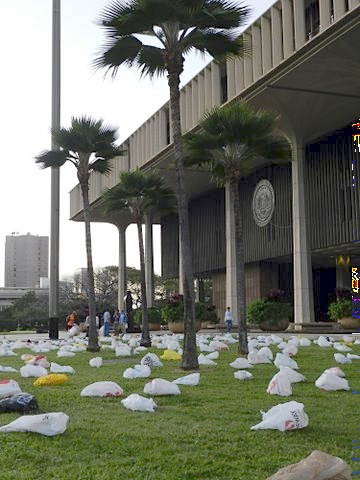Yes, those gigantic rotors in passes and on hillsides–where the winds blow steadily–do kill birds, according to the US Fish & Wildlife Service, about 33,000 annually. Why do I call it a myth, then? Because that number pales in comparison to the millions of migratory birds that die from window strikes (between 97 and 976 million — it’s hard to know exactly; Fish & Wildlife is estimating). Or the 4 to 5 million (possibly even 40 to 50 million) that collide with communication towers each year. Then there are non-collision causes, such as electrocutions (tens of thousands), pesticide deaths (72 million), and cat kills, which may run into the hundreds of millions annually. But that doesn’t stop conservatives and NIMBY opponents of wind-energy projects from scapegoating “killer turbines.” Robert Bryce, in a column in the Wall Street Journal (summarized in The Week on March 23), accused the Obama administration of a double standard by ignoring wind farms’ violations of wildlife protection laws while charging oil, gas, and electricity producers with breaking these same laws. In effect, as The Week puts it, under the sensationalist headline “The Deadly Threat from Wind Energy,” “the industry has a license to kill.” Bryce’s focus was recent news that even environmental groups are suing to stop some wind projects that endanger nearby bird populations, and the widely publicized estimates that nearly 10,000 birds, some of them protected species, fly into the turbines at Altamont Pass in California.
Now to why I call this an eco-myth: First, that’s the term used by John Laumer on Treehugger for the phenomenon of attacking the skyscraping rotors for being killers without comparing their mortality numbers with the millions or billions of birds dying from other threats. However, he also takes pains to show that the industry should improve the siting of wind farms and points to a new generation of turbines that promise to reduce the number of bird deaths (he cites the National Wind Coordinating Committee figure of 2.19 bird deaths per turbine per year). Second, the digest of Bryce’s column, in simplifying a complex story based on reporting, links environmentalists’ concern with climate change to a supposed inattention to wildlife harmed by wind energy, and thus overstates the charges Bryce is making. Whereas a former Naderite who worked for Public Citizen is the source of the analogy between whining about inattention to climate change and breaking wildlife protection laws, The Week makes it sound like Bryce is adding to the myth of wind energy’s effect on birds in order to discredit a promising alternative energy source:
For years, its [the green movement’s] members have complained that too few Americans were paying attention to the science of climate change. But they’ve ignored widespread evidence that their most beloved form of clean energy is devastating wild bird populations. To save the environment, it seems, you first have to wreck it.
The problem with this analogy is that it’s false; bird populations are not being devastated by wind farms. Again, according to the Fish & Wildlife Service, they are threatened by a variety of human activities, including not just the ones mentioned above but “loss and/or degradation of habitat due to human development and disturbance.” According to the website “How Stuff Works,” wind turbines cause only “about 1/10 of a percent of all ‘unnatural’ bird deaths in the US each year.” So why the hue and cry about killer turbines? A table showing the relative (man-made) causes of bird mortality at How Stuff Works shows that this is an eco-myth, reinforced by This Week much more than Bryce in the WSJ. Windmills as bird-o-matics? Not compared to cars and cats, transmission towers and brightly lit windows–not even remotely.

